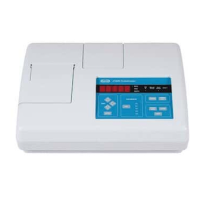SECTION 2, continued
25
2.6.3 Indexing and Matching Sample Cells
Precise measurement of multiple, low-turbidity samples requires good laboratory
technique to achieve accuracy and repeatability. Matched sample cells are
required to minimize the effects of optical variation among cells. Alternatively,
use a single sample cell for every measurement to minimize reading variability
caused by cell-to-cell imperfections. Using a single cell provides better accuracy
and precision than matched cells. Once cell orientation in the cell holder is
established, always use the alignment indicated on the cell, regardless of sample
cell choice (refer to Section 2.6.3.1). A Flow-Cell System provides the best
accuracy and reproducibility and is more convenient (see SECTION 5).
2.6.3.1 Indexing a Single Sample Cell
Add an orientation mark to a single sample cell as follows:
1. Fill the clean cell to the
line with high-quality water,
and cap the sample cell
(refer to Section 2.6.2).
2. Wipe the sample cell
clean, and apply a film of
silicone oil (refer to
Section 2.6.1).
3. Make sure the filter is in
place. Insert the sample cell
into the cell compartment,
and close the cell cover.
Record the reading.
4. Lift the cell
compartment cover, rotate
the sample cell (about
1
/8 of
a turn). Close the lid, press
ENTER and record the
reading. Continue this
procedure until the smallest
NTU reading is obtained.
Note: “door” is displayed when
the sample compartment is
not covered.
5. Place an orientation
mark on the sample cell
marking band adjacent to the
index mark. Use this mark to
align the sample cell each
time a measurement is made.
Tài liệu sưu tầm của Trung Sơn - www.tschem.com.vn - 028.3811.9991 - info@tschem.com.vn
Tài liệu sưu tầm của Trung Sơn - www.tschem.com.vn - 028.3811.9991 - info@tschem.com.vn

